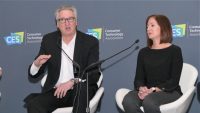CES Panel: Possibilities of Marrying 5G with Edge Computing
January 10, 2019
What is edge computing and what can it bring when married with 5G, asked TechRepublic editor-in-chief Jason Hiner, who moderated a CES panel on the topic. AT&T vice president Alicia Abella described edge computing in historical context, as the pendulum has swung back and forth from centralized computing (in the 1960s to 1980s) to compute power on the desktop (with the advent of the desktop PC), back again to a centralized notion with the cloud, and now back to a distributed model with edge computing.
“Edge computing is a new class of data center but rather than being in the cloud, the processing is closer to where you need it and distributed to many more locations,” she said. “The advantage of the edge is the ability to do compute processing more locally and deliver services and applications more quickly. And companies like AT&T save on backhaul traffic. It also cut down the latency from going to and from a data center that could be hundreds of thousands of miles away.”
IBM vice president/CTO of global telecom industry Craig Farrell (below left, with Abella) added that edge computing, “also gives you dynamic provisioning, the models of paying for what you use.”

ARM president of the IP products group Rene Haas noted that billions of edge computing devices — from voice-activated machines to toasters — combined with 5G will become smart. “They’ll have sensors and collect and communicate data and be more intelligent,” he said. “We see a large seachange for this extremely large market. It’s a key inflection point.”
Abella noted that AT&T’s launch of 5G this year was a major accomplishment. “We also have a commitment to autonomous vehicles (AVs), drones and many other use cases that will benefit from 5G and edge computing together.”
Farrell said edge computing is “a fundamental shift where computing and storage will happen so the kinds of applications will change.” “The edge shift is very important to us,” he said. “IBM sees itself as a major player in cloud, including edge cloud that can dynamically provision the service our customers want.”
Abella pointed out that marrying 5G with edge computing will offer advantages to AR and VR. Instead of the current paradigm of tethered use, 5G will enable mobile, untethered AR/VR. Adding edge computing means that “if you can do some of that processing on the edge, close to the device, and have 20 millisecond round trip latency now those goggles can become more lightweight and slimmer.”
“And that means they’re cheaper,” she said. “The devices will become more ubiquitous as the connectivity becomes ubiquitous.”
Farrell stressed the transformation of more connectivity. “The fact that you can connect one million devices in a square mile is a big jump from 4G,” he said. But Farrell squelched a supposition that 5G could be faster than fiber. “There’s no way that radio frequencies will go faster than fiber,” he said. “It’s a physics problem you can’t get over. Fiber won’t go away and it’s the best choice for backhaul. Fiber to the home is an investment that will be more valuable over time.”
He mentioned that the Romans didn’t know what kind of traffic would go on the roads they built centuries ago. Haas agreed, noting that when 4G’s throughput came into being, no one knew it would spawn Uber or Airbnb. “Nobody could imagine the disruptions of 4G and I think the same thing will happen with 5G,” he said.

No Comments Yet
You can be the first to comment!
Sorry, comments for this entry are closed at this time.